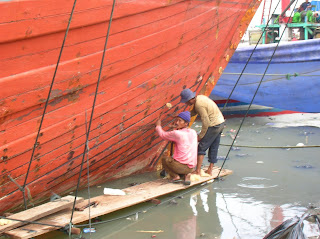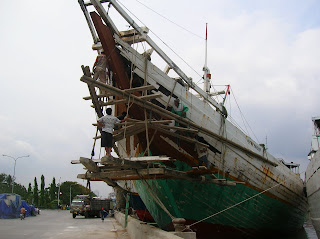
Today I ventured out of my buddy's housing complex (Dunia Bakrie!) to explore Jakarta a bit. My destination was the port of Sunda Kelapa in Jakarta. Although Jakarta is a major trading center with hundreds of large cargo ships calling annually, the port of Sunda Kelapa (Coconut of Sunda) is open only to the types of vessels you see in the picture above. This port has been active for at least 800 years and was the most important trading center for the Sunda kingdom, a powerful Hindu dynasty that ruled the western part of the island of Java for almost 1000 years between the 7th to the 16th centuries. The port has had a long history and has changed hands numerous times, being controlled variously by the Sundanese, the Portuguese, the Dutch, and several other kingdoms. Now most cargo moves through a newer multi-modal facility (like the kind you see at Honolulu Harbor), but a trip to Kelapa Sunda provides an introduction to the rich seafaring traditions of Indonesia.
These ships are called pinisi. They have traditionally been built by people from the southern part of the island of Sulawesi (1). The four main groups that have built pinisi include the Konjo, the Mandar, the Bugis, and the Makassarese (from Makassar). Among these groups the Bugis and the Makassarese are known for their strong traditions of seafaring. In addition to traveling and trading throughout the islands that would later become Indonesia, they were traveling to Australia to trade with the Aborigines long before Western explorers "discovered"(2) the Land Down Under. The Buginese and Makasarrese for hundreds of years been able to take advantage of their strategic location to make money from trading and piracy! You'd be amazed at how far the people from Indonesia were able to travel and spread; in fact they colonized Madagascar 1000 years ago, and the old Hawaiians are descendants of people that left the islands of Indonesia to explore the oceans thousands of years ago! If you're Hawaiian, you might have a distant cousin here! In the future keep your eyes peeled for a post about the similarities between Polynesian languages like Hawaiian and the languages of the Indonesian archipelago.

Although most of the ships were busy loading and unloading cargo, I was able to board a couple of them for a quick look around and short chat with the crew. I met two captains, Jakob from Maluku and Budi from Sulawesi. They told me they usually haul things like construction materials and fertilizer. As you can see from the pictures, there is a wide range of cargo. It takes about 3 days to get to either Sulawesi or Pekanbaru on Sumatra, two popular ports of call. Pak Jakob's ship was the larger of the two; he carried a crew of 12 while Pak Budi had a crew of 7. But Pak Budi's ship still goes the traditional route; when the winds are right he hoists his sails and lets the breeze carry him! Though most of the ships are rigged for sailing, I was told that many of them are relying more and more on their motors.

But from the looks of things, motors are one of the only extravagances...there didn't seem to be any radios or computer navigation equipment on either of the ships I visited.
You can also see from the pictures that running and maintaining these big boats is hard work. To load the cargo the crew uses either a crane-hoist or they hire hands at the port to manually carry goods across the narrow gang plank from ship to shore and vice versa.

Then there are the constant repairs. Even though some of these ships look ancient, Pak Jakob told me his ship (the one being repaired in the picture) was built about 25 years ago. The sea takes a heavy toll on these boats.
The best news of the

week though is that my research permit and visa was approved, which means that I'm now bona-fied and gen-you-ine. The notification I received requested that I go to Los Angeles to receive my special visa, though. I sure hope I can find a way to pick up the visa here!
(1) Jakarta, where I currently am, is on the island of Java. Sulawesi is another large island that is a part of Indonesia. Can you find it on the map?
(2) Why do you suppose I put the word "discovered" in quotation marks?
For Further Reading (and acknowledgments):
If your interested in the structure and construction of these fascinating ships, check out Michael Kasten's OUTSTANDING page on the Indonesian Phinisi at http://www.kastenmarine.com/phinisi_history.htm.
No comments:
Post a Comment